ORIGIN OF THE KERIS AND ITS DEVELOPMENT
TO THE 14TH CENTURY
A paper which sets forth evidence to be found in the
monuments of Central and East Java as the basis for a commentary
upon the origin and development of a traditional Javanese weapon.
by A.G. MAISEY
Abstract
The modern keris has existed since at least the mid 14th Century.
It developed in East Java from an earlier form known in Java
as the keris buda. The keris buda was preceded by and, coexisted
with, a Javanese dagger with a leaf shaped blade which resembled
the leaf shaped blades of Indian swords.
The period during which the keris buda, and its immediate
predecessor, came into being was the Early Classical Period (end
7th Century to end 9th Century). This period of Javanese history
was heavily influenced by Indian culture and ideas. The evidence,
although incomplete, points to the keris being a descendant of
the line of weaponry which embraces the leaf shaped blades of
India, and proposed by Rawson as " ...a common Aryan heritage
of the Indo Aryan peoples".
Note: In this paper keris buda, pre-modern keris and
Prambanan II have the same meaning, and modern keris and keris
have the same meaning.
Description
The keris is a South East Asian dagger.
Typically the blade of a keris is of asymmetric form, with
the blade wider on one side than on the other. The blade can
be either straight or with an uneven number of waves, is usually
about 12" to 15" long, and is sharpened on both edges.
The surface of the blade frequently bears a pattern, produced
during the forging process, and made visible by etching, which
is known as pamor.
The foregoing blade description relates to the modern keris,
which dates from at least the 14th Century. Some keris do deviate
from this description, however, for the purposes of this paper,
these deviations are not material.
Origin
A number of theories have been put forward to explain the
origin of the keris (Hill). These range from adaptation of a
broken spear, to development from the sting of the stingray.
Javanese and Malay traditions attribute origin to legendary figures.
An examination of these theories would use much time and space
and would contribute little. Suffice to say that when viewed
against evidence available in the country of origin of the keris,
Java, these theories are difficult to support or accept.
Solyom states: "We may only speculate about how and when
the keris and its manner of use evolved." He then goes on
to mention an early form of keris known in Java as keris buda,
which the Javanese attribute to the Central Javanese Hindu Buddhist
era (c. 700 A.D. to c. 900 A.D.). He comments further: "Apparently
no reliable dating has been obtained for them."
Examination of monumental evidence in Java demonstrates that
the keris buda did indeed exist during the Central Javanese period.
The same sites where representations of the keris buda can be
found, contain representations of another very similar dagger
which can reasonably be considered to be the direct predecessor
of the keris buda. The form of this predecessor is very similar
to the leaf shaped blades identified by Rawson as one of the
two chief forms of Indian sword blades. Considered in the time
and cultural frame work of the Central Javanese period this would
seem to indicate the influence of post-Gupta culture on this
weapon design. These blade forms are leaf shaped, waisted and
with a splayed base. Rawson states that, along with a second
Indian blade form, "Both these blade forms are consistently
represented in Greek vase paintings from antiquity, so it is
very probable that they are a common Aryan heritage of the Indo-Aryan
peoples."
Another point of similarity with Indian weapon design is in
the pommels shown on the swords and daggers of the Central Javanese
period. On the swords, these are the common Indian round disc,
surmounted by a small dome. On some of the daggers, this disc
has become an oblong shape (Harsrinuksmo, p.19), an alteration
which would facilitate a waist level, vertical carry.
Central Javanese Period (Early Classical)
It is generally accepted that there had been Indian contact
with Java from about the second century A.D. (Coedes). By the
early 8th Century, the Shailendras, a Buddhist dynasty, had established
themselves as rulers in Central Java. Between 775 A.D. and 864
A.D., during the reign of King Samaratunga, the great Buddhist
monument of Borobudur was completed, and was probably consecrated
in 824 A.D. (de Casparis). Not long after this, early in the
10th Century, the temple complex of Lara Jonggrang was completed.
The Lara Jonggrang complex is situated near the village of
Prambanan, not far from Jogjakarta in Central Java. Because of
its siting it is often referred to as Candi Prambanan (Prambanan
temple). This is a Hindu temple devoted to the worship of Shiva.
Both Borobudur and Prambanan are examples of Indian art and
architectural influence in Java. The architecture of Borobudur
is influenced by Indian Gupta and post-Gupta styles (Britannica),
and the art and architecture of Prambanan is a synthesis of northern
and southern Indian styles (Kempers). The reliefs at both these
monuments, although influenced by Indian culture, do not show
Indian settings, but place the stories related by the reliefs
in a Javanese context.
Borobudur
Harsrinuksmo reports a short weapon, similar to a keris, portrayed
in the reliefs of the Buddhist monument of Borobudur. I have
searched these reliefs several times in an effort to locate this
representation, but to date, I have had no success. A number
of other weapon types are shown, however, nothing remotely similar
to a keris has been identified.
Candi Prambanan (Lara Jonggrang)
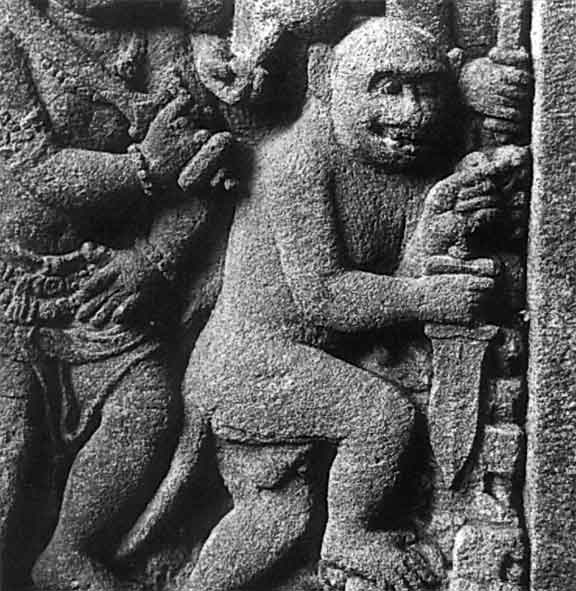
|
| 1. Prambanan I.
A monkey warrior holding a Prambanan I style dagger. The leaf
shaped blade is the great grandfather of the modern keris. Located
at Candi Shiva, Prambanan Temple Complex, Central Java. |
The temple complex at Prambanan consists of the central temple
of Shiva, flanked by the temple of Brahma (south) and Visnu (north),
and 5 smaller temples. On the inside of the balcony wall of Candi
Shiva, and continued on the balcony wall of Candi Brahma, the
story of the Ramayana is carved in relief. The relief carvings
of Candi Shiva contain at least three representations of weapons,
which I shall refer to as "Prambanan I", that I consider
to be forerunners of the keris buda. These weapons are daggers
with leaf shaped blades, splayed blade base, and with a separate
piece fitted to the blade base, as is the gonjo on a modern keris
blade. All are fitted with heavy pommels, topped by a dome, in
the Indian fashion, and are held in a manner which dictates an
overarm stab, rather than a thrust.
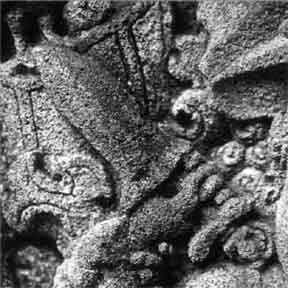
2. Above:
Prambanan II. Laksmana holding a Prambanan II style dagger.
All essential features of a keris are present, and the blade
form is what is now known as 'keris buda'. The handle, with its
heavy pommel, is designed for use with an overarm stab. Located
at Candi Shiva, Prambanan Temple Complex, Central Java.
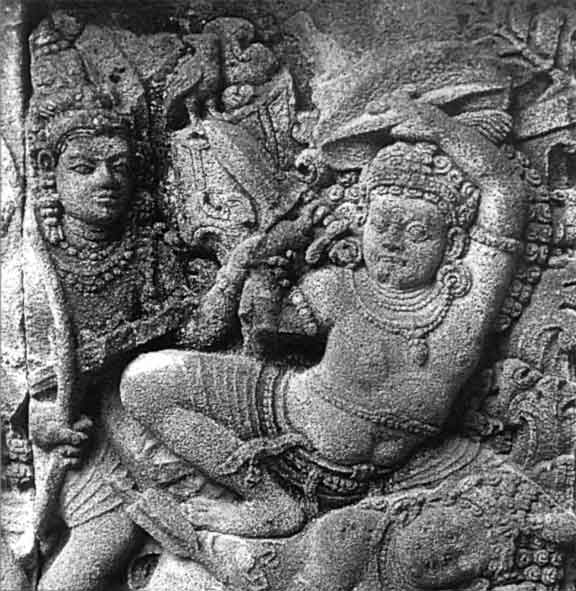 3.
3. Right:
Prambanan II. Close-up of the dagger
held by Laksmana in the photograph above.
The relief carving of panel No. 4, second scene, depicts Rama
and Laksmana killing the giants which are threatening Wismamitra's
hermitage (Moertjipto, Drs.). The dagger shown in this relief
bears an asymmetric base, defined gonjo, kusen, and odo-odo;
all features of a keris. I consider that this dagger, which I
shall refer to as "Prambanan II", is a representation
of a keris buda.
Candi Visnu carries a representation of at least one dagger
similar to Prambanan I in its relief carvings.
All the daggers mentioned above are short, broad, and heavy,
and of the same proportions as a keris buda. They display a leaf
shaped blade, with greater or lesser waist definition, a distinct
central ridge, and splayed blade base. Representations of swords
found in the same reliefs also carry leaf shaped blades, however,
of a form more suited to the cut, than to the thrust. Many are
similar to Rawson's Harasnath khanda, but I am not suggesting
a link here, because of the time difference. It is, however,
interesting to note the existence of a form similar to the Harasnath
khanda, in Central Java in the 9th Century, when Rawson places
this form in the 11th Century in India. Was this a separate Javanese
development from the same root, or did the Harasnath form exist
prior to the 11th Century?
The generally accepted date for completion of the Prambanan
complex is early 10th Century, however, evidence does exist in
the form of an inscription, dated to the year 856, which implies
that this temple complex already existed in that year (R. Soekmono,
in Fontein, p. 78).
East Javanese Period (Late Classical)
In the late 10th or early 11th Century, the centre of Javanese
cultural and political life shifted to the East. The first king
after the shift of the court from Central to East Java is known
to be King Sindok. He is mentioned in several inscriptions, the
earliest dating from 919. He claimed descent from the dynasty
of Mataram, which ruled in Central Java following the failure
of the Shailendras in about 870 (Vlekke).
We know little of East Java in the period from the arrival
of Sindok up until the establishment of the kingdom of Majapahit
in 1292. Sindok ruled over the kingdom of Kadiri, which was destroyed
around the year 1000. Airlangga reunified East Java, and then
divided his kingdom between his two sons. Almost nothing is known
of this period. In 1222 the kingdom of Singosari arose, followed
by Majapahit in 1292. Vlekke suggests that the constant change
in the centre of power during this period of Java's history indicates
the existence of a number of small principalities in more or
less permanent competition with each other. If this was the case,
the resulting political instability probably generated unrest
and a less than peaceful social environment. History tells us
that in such a social environment, the members of that society
customarily carry arms as they go about their daily business.
From this late classical period there are further examples
of the evolution of the keris. An 11th Century East Javanese
carving (Fontein, plate 19), shows a demon grasping a weapon
with two blades, both of which display the same short, broad,
heavy form with waisted blade, splayed base and heavy central
ridge, as found in the Prambanan I dagger. However, in this East
Javanese example, the blade features are more accentuated than
in the Prambanan examples.
Candi Singosari (c. 1300), located not far from present day
Malang, provides an example of gandik and gonjo, albeit, not
on a keris. These features, which are now accepted as being typical
of the keris, are found on a dagger with a jambiya shaped blade
and bearing a domed, disc shaped pommel (Fontein, plate 25).
Fontein also presents a 14th Century East Javanese finial,
which shows a man holding a keris of modern proportions. This
keris is held in the rapier like fashion of the modern keris.
In the Museum Mpu Tantular, in Surabaya, can be found a stone
carving of Durga originating from Candi Jawi (14th Century).
In one hand Durga grasps a dagger very similar to the Prambanan
II dagger, however, the form is considerably more refined, being
of a lighter construction than Prambanan II, and fitted with
a waved gonjo. This dagger is held in a manner which dictates
a thrust, rather than an overarm blow.
Candi Panataran
Candi Panataran is located near Blitar, and is the largest
temple complex in East Java. Its existence covers the period
from 1197 to 1454 (Kempers), and it is a Javanese Hindu complex.
The main temple at Panataran dates from 1347 (Kempers), and its
base carries reliefs telling the story of the Ramayana.
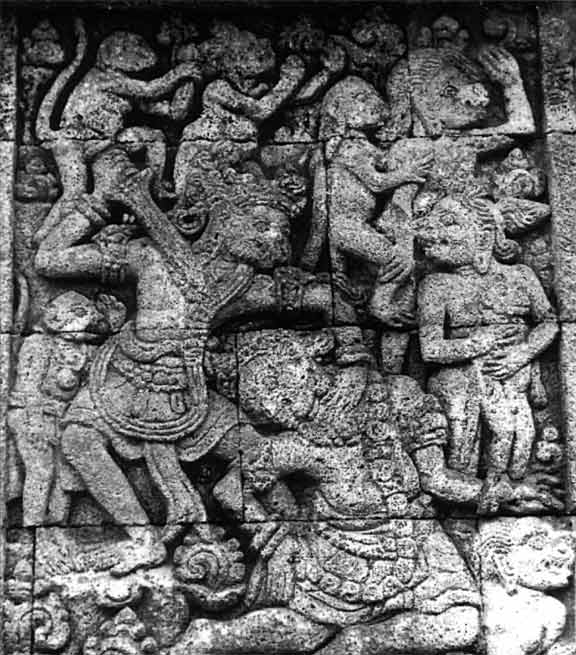
|
| 4. Prambanan
I after the move to East Java. Hanoman, The Monkey King, shown
using an elongated version of the Prambanan I style of dagger.
Located at Candi Panataran, East Java. |
There are many representations of weapons in these reliefs,
and swords, spears and daggers bearing blades similar to those
found in the reliefs of Prambanan can be identified. Included
in these representations of 14th Century Javanese weaponry is
a relief of Hanoman using a dagger with many of the features
of Prambanan I, and using it as an overarm stabbing weapon. However,
in the Panataran relief, this dagger has become a little longer
and proportionately thinner.
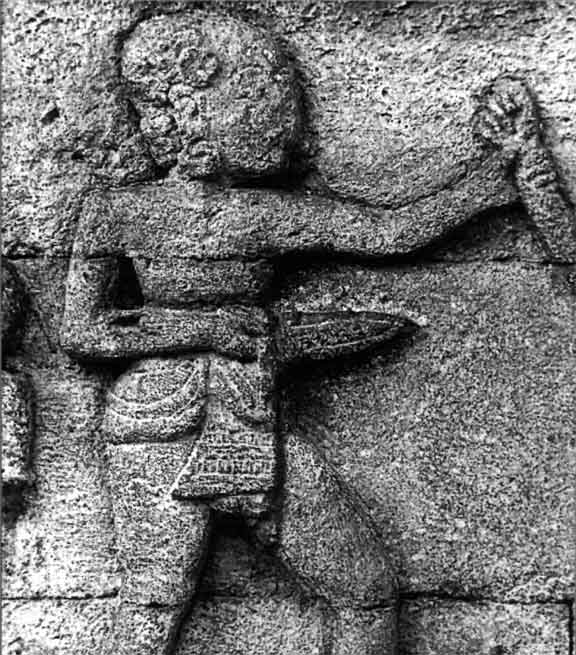
|
| 5. Prambanan
II style blade, but the handle is without the heavy pommel, thus
permitting the weapon to be used to thrust, rather than with
an overarm stab. This is the first monumental appearance of the
keris as a thrusting weapon, and is located at Candi Panataran,
East Java. |
There are several representations of keris in the Panataran
reliefs. Two of these representations are particularly interesting
in that one shows clearly the manner of use; and the other the
way in which the keris was worn. These keris are still represented
as short and broad, however, the relief which depicts use shows
that the grip has changed from an overarm stabbing grip to a
grip which will allow a rapier thrust. Moreover, the relief showing
the way in which a keris was worn demonstrates that the heavy
pommel of Prambanan II has disappeared.
Transition
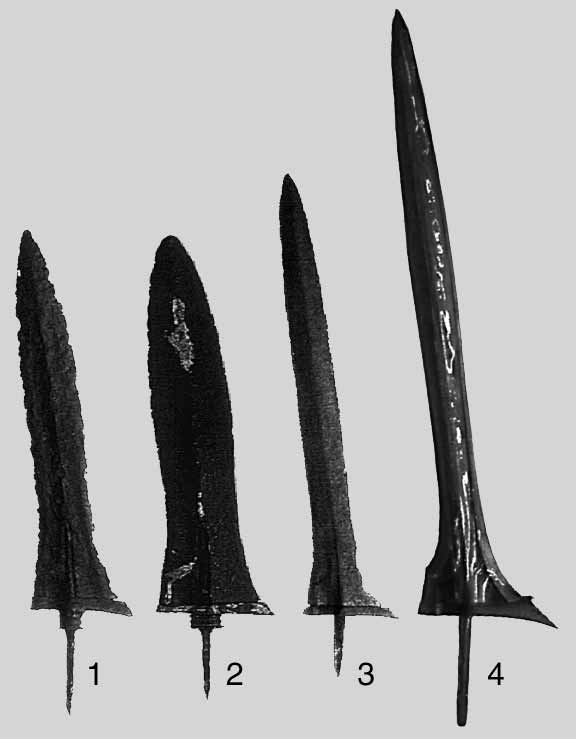
1 A keris
buda from the period 11th to 13th Century. No pamor is in evidence,
and the laminated construction technique has not yet appeared.
2 A
late keris buda. The blade is of early form, but laminated construction
was used, and pamor is in evidence. This keris was probably made
after the mid 14th Century, as a copy of an earlier piece.
3 Transitional
form of keris. In this blade the emergence of the modern keris
has begun. Some features of the keris buda are still in evidence,
such as the square tang, high gandik, and broad gonjo. However,
the tang, although still essentially square has a slight radius
on its front and back, and the blade has lengthened, and become
lighter. Close examination reveals residual traces of black iron
with what appears to be an inclusion of nickelous material. The
bulk of the blade material is heavily grained iron or steel,
and as it retains much of its original form, indicates that the
laminated outer skin would have been very thin. This blade appears
to be an early attempt at laminated construction, and probably
dates from 13th to 14th Century East Java.
4 A
modern keris, the blade executed in the Central Javanese Surakarta
style. This keris was made in 1987. |
Examination of physical specimens of pre-modern keris and
of early examples of modern keris, shows that on some pre-modern
keris, a line drawn through the centre of the blade deviates
from a line drawn through the centre of the tang by 3°, on
other pre-modern keris, this deviation is 8.5° to 9°,
and on the modern keris the deviation varies from 8° to 12.5°.
The smaller angle of deviation found on some pre-modern keris,
and resulting in a blade with a straighter presentation, is consistent
with a weapon used to stab overarm, whilst the wider angle of
deviation found on other pre-modern keris, and on all modern
keris, is consistent with the thrusting style of use of the modern
keris. The existence of two distinct angles of deviation in pre-modern
keris would seem to indicate that even before the appearance
of the modern keris, its immediate predecessor was being used
to thrust, as well as to stab.
Further evidence that the keris buda was used as, and developed
from a weapon used with an overarm stabbing action, is to be
found in the tang. The tang of the keris buda is of square section.
Such a tang was necessary to prevent the blade from turning in
the handle, something very undesirable in a weapon used with
a powerful overarm, downwards stabbing action. Conversely, the
tang of the modern keris is round, which allows adjustment of
the orientation of the blade to the grip, to suit the individual
user, a desirable feature of the keris used as a thrusting weapon,
which is unimportant where the weapon is used overarm.
Conclusion
In the period from at least 900 A.D. to circa 1300 A.D. stabbing
weapons with leaf shaped, waisted, splayed base blades, similar
in shape and mounting to Indian leaf shaped blades, were an established
form of Central and East Javanese weaponry. The existence of
a variation of this weapon, similar in all respects, except for
the shortening of one side of the splayed base, is substantiated
by representations of this weapon in relief carvings on monuments
in Central and East Java, dating from 10th to 14th Centuries.
It is an established fact that Indian culture and ideas were
a major factor in the development of Javanese culture from at
least the 8th Century.
The existence in Java of a weapon bearing similar blade shape
and mounting to a major Indian style indicates that the design
of the Javanese weapon was generated by the Indian design.
The variation of this dagger with one side of the splayed
base shortened, resulting in an asymmetric blade base, does not
exist in Indian weaponry. This weapon with leaf shaped blade
and asymmetric base is original to Java and marks the commencement
of the development of the keris. This weapon is known as the
"keris buda".
In Central Java the keris buda was used primarily, perhaps
solely, in an overarm stabbing action. In East Java, during the
period from circa 1000 A.D. to circa 1300 A.D., the keris buda
underwent changes which resulted in it becoming a longer, lighter,
thinner weapon, used to thrust, rather than with an overarm action.
These changes saw the appearance of the modern keris.
Reasons for Change
The development of the keris buda from Prambanan I, and the
modern keris from the keris buda can be supported with evidence,
and accepted with reasonable confidence. However, the reasons
for this development are pure hypothesis. Nonetheless, I would
like to present the following for your consideration.
As a rule form follows function. The Prambanan dagger which
eventually developed into the modern keris was a personal weapon.
If we can judge by later historical records of the society in
which this dagger was found, such personal weapons were carried
constantly (Groeneveldt). The mode of dress adopted in Java would
make carrying a dagger of the size and design of the Prambanan
dagger quite inconvenient. The manner in which such a dagger
was carried can be seen on a statue to be found in the north
alun-alun of the Surakarta Kraton (Harsrinuksmo, p. 19).
I submit that loss of the heavy pommel and refinement of the
blade form of the Prambanan daggers, were changes made to permit
more convenient wear of the dagger for someone in the everyday
dress of a sarung. When the pommel disappeared, and the blade
became lighter, the weapon became more suitable for use with
a rapier grip, than with an overarm action. As a rapier, the
blade became longer, and consequently thinner; for it to have
remained the same width and thickness would have made it too
slow for effective use as a thrusting weapon. As a thrusting
weapon, the necessity for a symmetrically splayed blade base,
acting as a cushion for the side of the hand, lessened, thus
the blade base became asymmetric, its function now simply to
support the first joint of the index finger.
Actually, the blade had already become asymmetric prior to
any modification along the lines outlined above. Witness Prambanan
II, the keris buda. The reason for this earlier adoption of asymmetric
form can possibly be explained by the grip used with the keris
buda. The shortened side of the blade base supports the fingers,
the longer side, the side of the hand. With the use of this grip
it is obvious that a projection in front of the fingers is unnecessary,
and in some circumstances could cause inconvenience.
The political unrest of the late classical period, prior to
Majapahit, is also a possible factor in the development of the
modern keris from the keris buda. In such times a light, fast,
thrusting weapon would tend to be more useful than a weapon used
with a slower overarm stabbing action. The lighter weight, and
greater convenience of carry of the modern keris would have tended
to see this longer, lighter, faster version of the Javanese personal
dagger, favoured over the heavier, slower keris buda. Particularly
so if the social environment was unsettled, and it was considered
desirable to always have a means of defence at hand.
However, without technological advancement in forge processes,
this development of a longer, lighter, faster, more convenient
weapon for personal use, may not have been able to be achieved.
Most keris buda do not carry pamor. "They are plain iron..."
(Solyom). Conversely one of the distinctive features of the modern
keris is its pamor. Weapons constructed with pamor are essentially
a sandwich; a core which forms the cutting edge, supported by
a laminated plate on either side. This form of blade construction
provides much more strength for equal cross section than does
a blade of homogenous construction. I believe it is probable
that weapons of pamor construction made their appearance in East
Java, during the same period which saw the modern keris developed,
that is, the three hundred years between 1000 A.D. and 1300 A.D.
It is possible that proximity to the north coast, and consequent
contact with traders from Persia and the Indian sub-continent
played some part in the technological advancement of forge processes,
which saw the introduction of blades of pamor construction.
The decrease in width of the blade caused a deterioration
in the capacity of the weapon to cause haemorrhage. In an effort
to compensate for this shortcoming a waved form of blade came
into being. This waving of the blade had the additional advantage
of allowing it to be more easily withdrawn from a wound. The
development of the distinctive features of sogokan, kembang kacang
and greneng were probably attempts to divert blood from the grip.
These changes had already taken place by the mid 14th Century.
Summary
The modern keris has existed since at least the mid 14th Century.
It originated in East Java and was a development of the keris
buda, which was a transitional form of an earlier dagger. The
development was occasioned by the custom of habitually carrying
a dagger as a personal weapon, and the mode of dress.
Bibliography
Britannica Encyclopedia, 15th Edition, 1983.
Casparis de, J.G., quoted in Forman.
Coedes, G.,
The Indianised States of South East Asia.
Fontein, Jan,
The Sculpture of Indonesia.
Forman, B.,
Borobudur.
Groeneveldt, W.P.,
Historical notes on Indonesia and Malaya
compiled from Chinese sources.
Harsrinuksmo, Bambang,
Ensiklopedi Budaya Nasional.
Hill, A.H. (M.A., D, Phil)
The Keris and Other Malay Weapons,
Journal of the Malayan Branch of the Royal Asiatic Society, Vol.
29, Part 4, No. 176.
Kempers, A.J. Bernet,
Ancient Indonesian Art.
Moertjipto, Drs., Prasetyo, Drs., B., Kusumo, Drs., I.D.,
Darmoyo.
The Ramayana Reliefs of Prambanan.
Rawson, P.S.,
The Indian Sword.
Soekmono, R., in Fontein.
Solyom, Garrett and Bronwyn,
The World of the Javanese
Keris.
Vlekke, Bernard H.M.
Nusantara.
Source: vikingsword.com



































